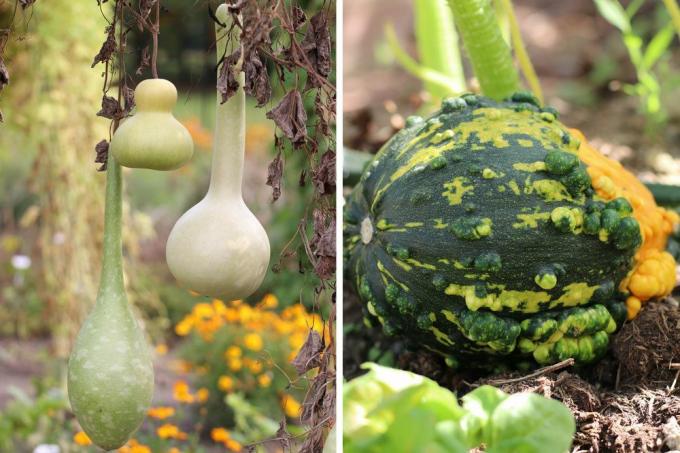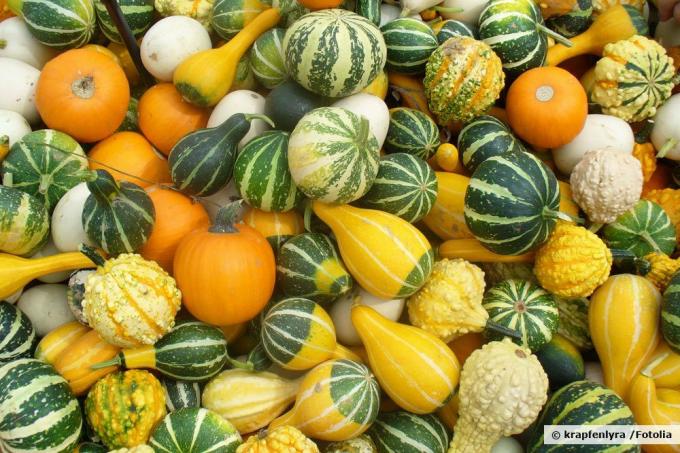
table of contents
- Ornamental Pumpkins
- The ideal harvest time
- Harvest decorative pumpkins properly
- cleaning
- disinfection
- Preserving decorative pumpkins
- 1. Short-term preservation
- 2. storage
- 3. dry
- Alternative: hang up decorative pumpkins
- Periodic review
Ornamental pumpkins are an indispensable element of autumn decorations. But sooner or later the pretty fruits become wrinkled or start to rot from the inside out. The shelf life of the pumpkins can be extended in different ways. It starts with the right harvest and extends to tried and tested methods of preservation. In this article we will explain to you how to determine the perfect harvest time, how to harvest it properly and how to preserve the fruit for a long time.
Ornamental Pumpkins
As with edible pumpkins, ornamental pumpkins are annual climbing or climbing plants with impressive growth rates. From summer onwards, the fruits develop on the plant. Ornamental pumpkins can be single or multi-colored, but what they all have in common is their unusual, sometimes bizarre shape. Real decorative pumpkins are less suitable for consumption. This is not only due to the fact that they contain little fruit pulp, but a lot of bitter substances. Many ornamental pumpkin varieties also contain cucurbitacin, which is for humans
poisonous is. For this reason, the pure decorative pumpkins can only be used as pretty decorative elements. The most popular varieties include:- Autumn Wing (Indian Pumpkin)
- Pear bicolor
- Dancing or Spining Gourd
- Bottle gourd (calabashes)
- Mini ball
- Devil's claws
- Trombolino
- Wart gourd

The ideal harvest time
Most ornamental pumpkin varieties take between 85 and 120 days from sowing to setting the fruits. However, you will have to wait a few more weeks for them to mature well. Immature pumpkins are difficult to store. The harvest of ornamental pumpkins begins, depending on the variety, the time of sowing and the weather, in summer and continues into autumn. If the weather permits, then leave the ornamental gourds on the mother plant for as long as possible. However, cut the pumpkin fruits off before the first frost. The cold temperatures ruin the beautiful skin and also reduce the shelf life. You can tell when the pumpkin is ripe by the following characteristics:
- colorful outer skin (for example a rich orange)
- Death of the mother plant
- hard shell that is difficult to pierce
- sounds hollow when knocking
- dry, slightly woody handle
- The stem must no longer shine
- preferably harvest around noon on dry days
Harvest decorative pumpkins properly
Always work with clean and sharp cutting tools when harvesting, so that a smooth, small cut is created that can dry off quickly. Large wounds, such as those that occur when breaking off, heal poorly and are therefore potential entry points for pathogens and germs. Suitable tools are either secateurs or a sharp knife. Examine each individual fruit closely after harvesting. If it has bruises, injuries or already rotten spots, it is best to throw this copy away immediately. It is not suitable for preservation. Fungi, bacteria or viruses can penetrate through the damaged areas and promote decomposition. In the worst case, the rot spreads to the neighboring ornamental gourds and destroys the entire harvest. Only fruits that have an absolutely undamaged outer skin are suitable for drying or storage.
- Leave 3 to 5 cm of the stem on the pumpkin
- Leave dried flowers on the fruit
cleaning
The main cause of the rotting of the pumpkins after harvesting is not just the high water content, but before especially contact with germs such as fungi and bacteria that decompose the fruit and cause mold to grow to lead. Ornamental pumpkins are usually a little less endangered than their edible relatives, as they contain significantly less pulp and therefore less water. Nevertheless, there is a great risk that the fruit will rot after a short time. Therefore, the peel should be cleaned after harvesting. Preferably use a soft cloth for cleaning. Steel wool or brushes can damage the sensitive outer skin.
- Wash off in the sink with lukewarm soapy water
- Rinse with clear, cold water
- Let dry on newspaper or kitchen paper
disinfection
In order to kill deeper-seated germs, you can put the pumpkins in a bath with diluted household bleach for a short time after cleaning and then rinse them off with clear water. Make sure you have the necessary protective equipment. Safety glasses and gloves are strongly recommended when working with the bleach. Alternatively, you can rub the dry fruits with alcohol.
Preserving decorative pumpkins
There are various methods of counteracting decomposition. When choosing it, it depends above all on whether the decorative pumpkin should stay fresh or last a long time as a decorative object. As a rule, the harder the skin of a pumpkin is and the less pulp it contains, the better it can be preserved.
Pre-drying
After cleaning, it is important that the pumpkin is allowed to dry off well. However, do not store the pumpkins in the blazing sun, as the sun's rays bleach the colorful skin. In addition, high temperatures promote the decomposition inside, so that the pulp begins to ferment or rot.
- well-ventilated, shady place outdoors
- in damp weather conditions: shady, warm window sill
- Temperature: 15 ° C to 20 ° C
- Base: newspaper or wooden board
- turn occasionally
In mild, dry weather conditions, the pumpkin skin is already well dried on the vine. The situation is different if the harvest takes place in damp or cool weather. In this case, the pumpkins need to pre-dry for about a week.
1. Short-term preservation
If you want to use the pumpkins as autumn decorations right away, you can rub their skin with wax after cleaning and drying. This keeps pathogens away and also ensures a nice shine. Are suitable:
- Beeswax
- vaseline
- Floor wax (smells a bit strong, however)
Note: Lacquers of any kind are not suitable for preserving a fresh pumpkin.
2. storage
It is possible to store an ornamental gourd in a cool, dry room for up to several months. It is important to keep the water in the fruit for as long as possible and thus keep it fresh and crisp. Place the cleaned and pre-dried decorative pumpkins preferably in a wooden box or on wooden boards. The air can circulate better and the pumpkin can dry off if something is covered with crumpled up newspaper or straw. The individual fruits must not touch each other during storage, so leave enough space between them and do not stack the pumpkins on top of each other.
- Temperature: 12 ° C to 18 ° C
- dry
- good air circulation
- as dark as possible (no direct sunlight)
- low humidity (to protect against mold)
- do not store in the refrigerator (too moist and too cold)
- turn occasionally
- Shelf life: depending on the variety between three and five months
3. dry
The best way to preserve decorative pumpkins for a long time is to dry them. However, not all varieties are equally suitable for this type of preservation. Fruits with a soft skin and thick flesh shrink when they release larger amounts of water, so that their attractive shape is lost. It is different with hard-skinned ornamental pumpkin varieties such as the bottle gourd. The shell is so stable that it does not give in when it dries.
method
You will get the best result if you dry the washed and disinfected pumpkin in two steps. First of all (as described above) the superficial moisture must be eliminated. The second step is then to dry the pulp inside the hard shell. Drying the inside of the pumpkin takes a little more persistence and care. Slow drying is the top priority for successful preservation. If the moisture is released too quickly, the fruit will shrivel and can no longer be used for decoration purposes. Depending on the variety and environmental conditions, drying can take between three and six months, in extreme cases up to a year. You can tell when the pumpkin is ready for use by lifting it up. If it feels very light and rattles when shaken, it is dry.
Optimal conditions:
- dark
- Temperature: 15 ° C to 20 ° C
- the lower the humidity, the better
- optimal are below 25%
- Garage, attic, dry basement or pantry
- Support: newspaper, sawdust or straw
- turn every few weeks
tip: To freshen up the color, you can rub the dried fruit with beeswax.
Alternative: hang up decorative pumpkins
Ornamental pumpkins dry even better if you hang them up. In this way you avoid pressure points and accumulations of moisture that lead to spoilage. Just wrap a thick thread and stem and hang it in a dry, dark place. The pumpkins are not allowed to touch the wall or each other, but have to hang freely. In general, it is possible to drill a few holes in the bottom of the pumpkin so that the moisture can escape better. However, there is a very high risk of introducing germs inside, which lead to rapid rot. To prevent the leaking juice from leaving unsightly stains, you should place a flower coaster or an old bowl underneath.
tip: When drilling, make sure that you always use a freshly disinfected tool, such as a drill dipped in alcohol.
Periodic review
Check the pumpkins about once a week and discard any specimens that begin to rot, shrivel, or soften. Despite the best storage conditions, mold can occasionally form on the shell. But that doesn't mean the gourd is lost. Simply wipe it with a dry cloth or a cloth dipped in bleach. If the pumpkin is still nice and hard, it should be fine despite its appearance.






